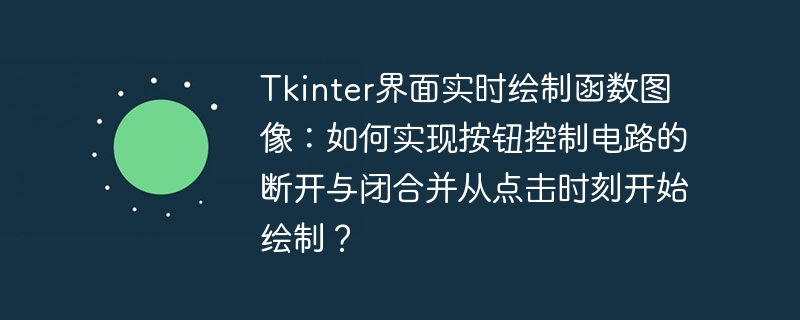Tkinter界面实时绘制函数图像:如何实现按钮控制电路的断开与闭合并从点击时刻开始绘制?
时间:2024-11-19 12:04:05 291浏览 收藏
编程并不是一个机械性的工作,而是需要有思考,有创新的工作,语法是固定的,但解决问题的思路则是依靠人的思维,这就需要我们坚持学习和更新自己的知识。今天golang学习网就整理分享《Tkinter界面实时绘制函数图像:如何实现按钮控制电路的断开与闭合并从点击时刻开始绘制? 》,文章讲解的知识点主要包括,如果你对文章方面的知识点感兴趣,就不要错过golang学习网,在这可以对大家的知识积累有所帮助,助力开发能力的提升。

设计tkinter控制按钮,实时生成函数图像
问题:使用tkinter设计了界面,但点击按钮后,函数图像从0开始,而不是按钮点击时刻开始,无法实现电路的断开和闭合。
解决方案:
修改代码中的关键部分:
def toggle_manual_switch(self):
# 获取当前时刻的索引
current_index = int(self.current_time_index)
# 进行状态切换
self.simulator.switch_states[current_index] = not self.simulator.switch_states[current_index]
# 更新按钮文本和命令
if self.manual_switch_button["text"] == "Close Circuit":
self.manual_switch_button["text"] = "Open Circuit"
else:
self.manual_switch_button["text"] = "Close Circuit"
# 更新整个图表,传递当前时间点的索引
self.update_plot(current_index)
self.canvas.draw_idle()
def calculate_circuit_response(self, current_time_index):
# 检查当前时间点是否有开关切换发生
if current_time_index > self.previous_switch_time_index:
# 检查当前时间点的开关状态是否与前一时刻不同
if self.switch_states[current_time_index] != self.switch_states[current_time_index - 1]:
self.previous_switch_state = not self.previous_switch_state
next_switch_index = current_time_index + np.argmax(
self.switch_states[current_time_index:] != self.switch_states[current_time_index])
if not self.previous_switch_state:
# 开关断开
self.VoltageOverTime[current_time_index:] = 0
self.CurrentOverTime[current_time_index:] = 0
else:
# 开关闭合
self.VoltageOverTime[current_time_index:] = V_battery * np.ones_like(self.VoltageOverTime[current_time_index:])
self.CurrentOverTime[current_time_index:] = V_battery / R_load * np.ones_like(self.CurrentOverTime[current_time_index:])
# 更新上一次开关切换的时间索引
self.previous_switch_time_index = next_switch_index
def update_plot(self, frame):
self.simulator.calculate_circuit_response(frame)
time = t[frame]
# 更新时间索引
self.current_time_index = frame
V_circuit = self.simulator.VoltageOverTime[:frame + 1]
I_circuit = self.simulator.CurrentOverTime[:frame + 1]
self.V_line.set_data(t[:len(V_circuit)], V_circuit)
self.I_line.set_data(t[:len(I_circuit)], I_circuit)
self.axs[0].set_xlim(0, t_max)
self.axs[1].set_xlim(0, t_max)
self.axs[0].set_ylim(0, 20)
self.axs[1].set_ylim(0, 2)
print("Plot updated") # 添加这行代码来确认图表是否被更新
print("Plot Voltage:", V_circuit[-1], "V")
return self.V_line, self.I_line特点:
- 修改了update_plot函数,更新了时间索引current_time_index。
- 修改了calculate_circuit_response函数,即使仅发生一次状态切换,也能更新电压和电流值。
- 修改了toggle_manual_switch函数,点击按钮后直接进行状态切换。
这些修改后,电路可以从按钮点击时刻开始绘制,并且按钮操作能够实现电路的断开和闭合。
以上就是本文的全部内容了,是否有顺利帮助你解决问题?若是能给你带来学习上的帮助,请大家多多支持golang学习网!更多关于文章的相关知识,也可关注golang学习网公众号。
相关阅读
更多>
-
501 收藏
-
501 收藏
-
501 收藏
-
501 收藏
-
501 收藏
最新阅读
更多>
-
144 收藏
-
133 收藏
-
315 收藏
-
370 收藏
-
238 收藏
-
454 收藏
-
303 收藏
-
169 收藏
-
465 收藏
-
357 收藏
-
424 收藏
-
418 收藏
课程推荐
更多>
-

- 前端进阶之JavaScript设计模式
- 设计模式是开发人员在软件开发过程中面临一般问题时的解决方案,代表了最佳的实践。本课程的主打内容包括JS常见设计模式以及具体应用场景,打造一站式知识长龙服务,适合有JS基础的同学学习。
- 立即学习 543次学习
-

- GO语言核心编程课程
- 本课程采用真实案例,全面具体可落地,从理论到实践,一步一步将GO核心编程技术、编程思想、底层实现融会贯通,使学习者贴近时代脉搏,做IT互联网时代的弄潮儿。
- 立即学习 516次学习
-

- 简单聊聊mysql8与网络通信
- 如有问题加微信:Le-studyg;在课程中,我们将首先介绍MySQL8的新特性,包括性能优化、安全增强、新数据类型等,帮助学生快速熟悉MySQL8的最新功能。接着,我们将深入解析MySQL的网络通信机制,包括协议、连接管理、数据传输等,让
- 立即学习 500次学习
-

- JavaScript正则表达式基础与实战
- 在任何一门编程语言中,正则表达式,都是一项重要的知识,它提供了高效的字符串匹配与捕获机制,可以极大的简化程序设计。
- 立即学习 487次学习
-

- 从零制作响应式网站—Grid布局
- 本系列教程将展示从零制作一个假想的网络科技公司官网,分为导航,轮播,关于我们,成功案例,服务流程,团队介绍,数据部分,公司动态,底部信息等内容区块。网站整体采用CSSGrid布局,支持响应式,有流畅过渡和展现动画。
- 立即学习 485次学习
